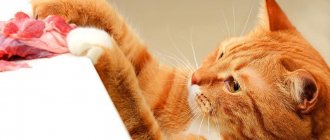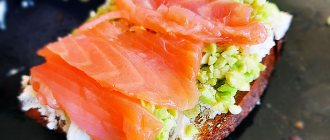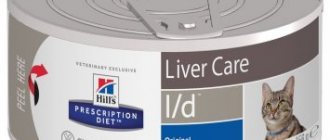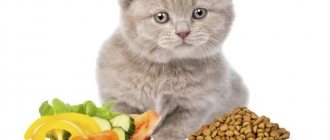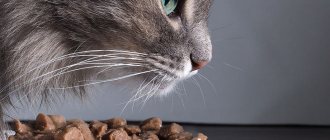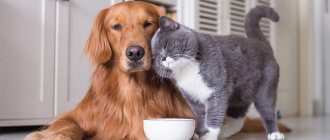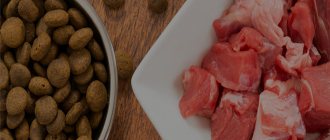Veterinarians believe that chicken meat is a healthy product for cats due to its high protein content, micro- and macroelements. The pet's diet should also contain by-products - kidneys, liver, hearts and stomach. Poultry is the healthiest because it does not contain antibiotics or salt, which is used to artificially increase weight.
Is it possible to feed cats raw chicken?
A balanced natural diet includes a significant intake of animal protein, which is most easily digestible by carnivores.
A cat's short intestinal tract is genetically designed to digest soft meat fibers. Chicken fillet has a number of advantages:
- contains essential amino acids;
- low in calories, low in fat, rich in proteins;
- easy to digest;
- inexpensive.
Raw broiler chicken meat is preferable to boiled meat in a cat’s diet. Cooking destroys most of the vitamins and microelements. The stomach and digestive tract of cats are well adapted to digest raw meat. Boiled chicken is dehydrated and creates a risk of constipation. The raw product takes longer to digest and saturates the pet longer.
Chicken breast (dietary white meat) contains little cholesterol and is rich in magnesium. Legs (red meat) contain a high content of iron and zinc. More juicy, they are more readily eaten by cats.
Chicken by-products:
- Liver - contains iron, folic acid, vitamins A, B, C and D. It can cause diarrhea, it is included in the diet 1-2 times a week.
- The heart and stomachs are made of muscle tissue and are difficult to chew. They are crushed before feeding.
By-products should make up 5-10% of a cat's diet.
Possible problems
Sometimes kittens have problems when feeding meat. Let's list the most typical ones.
Kitten vomits raw meat
If a kitten vomits raw meat, then most likely he ate too much at one time. Some kittens do not know how to control their eating behavior, attacking food like crazy and eating everything they see. Such kittens should be limited by giving food in strictly measured portions. Even if it seemed to you that the kitten vomited after eating a small amount of meat, perhaps you were just measuring by eye and that’s why its portion seemed small. So use a kitchen scale.
Also, the cause of regurgitation may be intolerance to any type of meat. Pay attention to what exactly the kitten regurgitates. If it is always the same type of meat, you will have to give it up.
In addition, regurgitation of hard food such as gizzards or bones may occur.
In addition, if the kitten is 2-3 months old or more, and he is accustomed only to industrial food, problems associated with enzyme deficiency may arise with the consumption of meat.
EXPERT COMMENT: CANDIDATE OF BIOLOGICAL SCIENCES GALINA CHILIKINA
“Any dry food is granules that have a porous structure and contain almost digested food, so enzymes are not required to digest dry food. Entering the stomach through the esophagus, these granules begin to absorb gastric juice, under the influence of which they turn into a homogeneous liquid gruel, which in turn enters the small intestine, where absorption occurs. The movement of this liquid gruel from the stomach into the intestines occurs almost by gravity, so contraction of the walls of the stomach and intestines is not required. Therefore, the motility of the gastrointestinal tract in cats eating exclusively dry food is very sluggish. Thus, dry industrial food takes over the functions of the body, and this leads to the fact that the cat does not produce enzymes intended for breaking down and digesting natural food.”
Kitten eats only meat
This is normal, no need to worry. The kitten is a predator, it is supposed to eat meat. All other products (fermented milk, fish, vegetables, eggs) are food additives that may not be in the diet. And even more so, do not feed kittens cereals that are harmful to them.
Kitten doesn't want to eat meat
But this situation, on the contrary, requires careful study. All kittens, when they reach the age of 1 month, are already able to absorb some amount of meat. After all, at 2 months they will have to wean themselves from their mother’s breast and eat on their own. If a very small kitten refuses meat, then it is simply too early for him to eat it. If we are talking about a 2-month-old kitten, then it needs to be examined. Typically, this behavior is associated with gastrointestinal pathologies.
Some cats refuse to eat meat if they have been taught to eat dry food. Adult cats can sometimes be very difficult to retrain. But with kittens that previously ate dry food, as a rule, there are no problems when switching to meat. Kittens are open to everything new and it is quite simple to form in them the food preferences needed by the owner.
At what age can kittens be fed raw chicken?
Raw chicken is a tender, easily digestible product containing all the necessary substances for rapid growth. It can be given to kittens as complementary food starting from one month. At this time, babies still need mother's milk, but are already trying adult food. The breast is rolled in the freezer, small balls are formed from the minced meat and frozen. Food at room temperature is given in a bowl. The kitten eats with its mother, she teaches him to chew.
Two-month-old kittens can be given pieces of raw chicken, as solid food has a beneficial effect on the condition of baby teeth and forms a correct bite. After defrosting, a 40-50 g portion is cut into pieces that the kitten cannot swallow whole. By tearing off parts of the fibers, young seals train their jaw muscles, realizing their predator instinct.
At three months of age, chicken becomes a complete diet. Raw fillet can be given daily in an amount equal to 10% of the animal's weight.
Choosing food: where to start
The first step is a consultation with your veterinarian. The specialist will take tests, examine the animal and create a suitable diet. This also applies to situations when a cat refuses to eat its usual food - only a doctor can determine the reason and select a new food.
Even if it is not possible to show the animal to a doctor, you can go for a consultation yourself, ask for advice in an online chat on the clinic’s website or a veterinary forum. Also, some pet stores have a veterinarian's office where you can talk to a specialist.
What to consider when choosing food:
- age of the animal - kittens need more high-calorie food, and aging cats need more fiber;
- individual needs - free-range animal, overweight, pregnancy;
- pathologies - for example, with urolithiasis and kidney failure, dietary food is needed.
Manufacturers suggest taking into account the breed of the cat. But, according to veterinarians, the anatomy and physiology of the animal are important. For example, Maine Coons need fatty acids to prevent joint diseases, but special food for them is also suitable for other large cats. And food for Persian cats with a high fiber content can be given to long-haired animals with a similar facial structure.
The main danger when choosing nutrition without consulting a doctor is an unbalanced diet. For example, animals that eat only meat may have low calcium levels. This leads to problems with the musculoskeletal system, lethargy, obesity and constipation.
The clinic periodically receives kittens with fractures due to juvenile hyperparathyroidism, a disease that occurs against the background of an unbalanced diet. This is the result of owners giving the cat only meat or low quality food. Meat is low in calcium and high in phosphorus: their ratio in beef is 1:10, in liver and heart - 1:50. And in a balanced cat diet, the ratio of calcium to phosphorus should be approximately 1:1.
How to properly feed chicken breast and fillet to cats
You cannot feed your animal chicken alone - you need to alternate it with beef, rabbit, turkey and other sources of proteins.
A serving of chicken fillet for one feeding of an adult is 100-120 g. Before use, the chicken is defrosted and the resulting moisture is drained. A large amount of liquid indicates repeated freezing of the product or pumping of the pulp with a brine solution to increase the weight of the chicken. In this case, you should change the supplier.
The meat is cut into medium-sized pieces. The cat must bite and chew the food itself, stimulating the process of secretion of gastric juice. The chicken is served at room temperature, the product is not salted. It is unacceptable to feed raw and cooked meat at the same time. The release of various enzymes in the stomach leads to indigestion.
Mr. Cat recommends: precautions
Veterinarians recommend checking any domestic cat for parasites from time to time. For prevention, it is necessary to take a course of anthelmintic drugs. The frequency of courses is two or three times a year. This is especially necessary for cats that are fed natural food. This is due to the fact that there are no methods of processing meat at home that will completely disinfect it and protect the cat from parasites.
In addition, you should know that a pet can become infected with helminthiasis in various ways, not only through eating raw meat.
Often, owners feed their pets both raw and cooked meat. This can be done, but you need to give the product with different degrees of processing at different times. The fact is that to digest raw, half-raw and cooked meat, enzymes with varying degrees of activity are produced. They cannot be produced in the body at the same time, so after feeding your pet raw meat, the boiled product can be given no earlier than three hours later.
Why is raw chicken dangerous for cats?
Only fillets and offal can be used for pet food. The tubular bones of chickens are hollow inside. Their fragments can injure the mucous membranes of the oral cavity and gastrointestinal tract. The heads and paws contain sharp parts and are not used as cat food. Tendons and cartilage require careful chewing, and cats swallow food in chunks. Rough food can cause inflammation of the gastric mucosa.
Chicken skin is difficult to digest and contains a large amount of fat. Acids and salts used when deboning poultry are preserved on its surface. To avoid digestive problems, the skin is carefully removed.
Broiler chicken is considered a dietary food, but often causes allergies in animals. It is not the product itself that causes painful reactions, but the antibiotics used in poultry farms and the chemicals used to process carcasses. A cat suffering from food allergies is given a small piece of chicken for the first time and its condition is monitored. The occurrence of diarrhea, watery eyes, and itching requires exclusion of the product from the diet.
Thermally untreated poultry may contain larvae and eggs of worms, pathogenic bacteria - salmonella, listeria. The product may be contaminated with E. coli.
What role does it play in a cat's diet?
Everyone knows that cats are predators. Therefore, raw meat for these animals is a natural and main component of the diet. The share of this product in the daily cat menu can reach up to 80%. Regular consumption of meat provides the cat with the necessary proteins and amino acids, which play a key role in the formation of the bone skeleton and muscle tissue.
Is it worth feeding a cat raw meat? Many owners are interested in it.
Their deficiency, especially taurine, can cause serious health problems and can lead to:
- blindness;
- deterioration of wool quality;
- baldness;
- heart failure;
- disruption of the normal functioning of the endocrine system.
For your information! Some breeders try to compensate for taurine deficiency by including foods rich in plant protein in the cat's diet. However, it should be noted that in protein foods of plant origin there is either no taurine at all, or it is found in negligible quantities.
How to keep chicken safe for cats
Thermally untreated chicken may contain pathogens of toxoplasmosis, heterakis nematodes, and roundworm larvae. Deep industrial freezing at a temperature of -30˚C kills parasites in 6 hours. Household refrigerators are capable of providing a temperature of -18˚С.
Chicken meat is disinfected as follows:
- the bird is freed from skin and bones, cut into portions, placed in the freezer in plastic bags;
- parts of the carcass are frozen for at least 4 days;
- If necessary, fillet pieces are thawed and cut into pieces of the required size.
A cat's gastric juice is highly acidic, allowing it to cope with most pathogenic microorganisms. Salmonella and E. coli develop in dangerous quantities on stale, poor-quality products. Only fresh, uncured meat is suitable for feeding pets. It is preferable to purchase chickens from farms or in large stores and markets, where the products have a certificate of veterinary control.
Raw chicken meat processed at low temperatures is a healthy product, a source of easily digestible animal protein, vitamins and minerals. Cats and kittens willingly eat chicken without danger to their health.
What is better - buying or cooking?
Experts believe that everything depends on the capabilities of the owner and the preferences of the pet. Both options have their pros and cons.
Industrial feed is convenient - just open the package and measure out the desired portion. But it is difficult to fully understand their composition - it is not always indicated on the packaging, and it is simply impossible to check the quality of the ingredients.
You can choose products for natural nutrition yourself, but this requires the skills of both a nutritionist and a cook.
Natural food is better than industrial food if three conditions are met: the diet is balanced, the quality of the products is high and there is time to prepare food for the animal.
